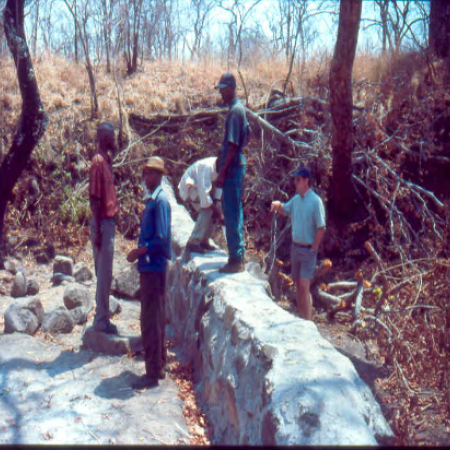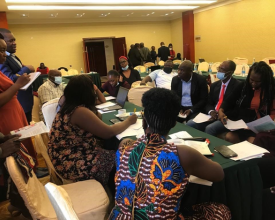Mejora de la gobernanza y la conservación en la gestión de áreas protegidas de biodiversidad.

La gobernanza se consideró uno de los principales retos para la conservación comunitaria y la gestión de la biodiversidad de las zonas protegidas de Zambia. Se puso en marcha un proyecto destinado a mejorar la gobernanza de la gestión comunitaria de los recursos naturales para obtener mejores resultados de conservación y sociales abordando las prioridades para mejorar la gestión y la gobernanza. Se utilizó una evaluación de la gobernanza y la equidad a nivel de sitio (SAGE) y la evaluación de la gobernanza de las áreas protegidas (GAPA) para identificar las lagunas en la gobernanza y desarrollar acciones mediante la participación de las partes interesadas. Este proyecto se llevó a cabo en 6 GMA de los paisajes de Kafue y el Bajo Zambeze. Las actividades se llevaron a cabo en 12 CRB y 67 VAG, y más del 60% de las mujeres y los jóvenes participaron en el programa de capacitación.
Contexto
Défis à relever
Entre los principales problemas abordados figuran los de gobernanza (como la falta de concienciación, la aplicación injusta de la ley, los conflictos entre personas y animales salvajes, la falta de coordinación entre las partes interesadas y las amenazas a la conservación de la biodiversidad por el uso insostenible de los recursos y los escasos beneficios que obtienen las comunidades locales).
Los retos se abordaron desarrollando la capacidad de las organizaciones comunitarias en materia de gestión comunitaria de los recursos naturales para mejorar la gobernanza y contribuir a la gestión de la biodiversidad de las zonas protegidas. El proyecto utiliza las herramientas SAGE y GAPA para evaluar el rendimiento de la gobernanza y la equidad a nivel de sitio en las áreas protegidas. A partir del estudio de referencia y la planificación de acciones, se identificaron actividades y el proyecto facilitó apoyo para abordar algunas de las cuestiones de gobernanza, como el fomento del diálogo sobre la invasión, la aplicación de la ley, el intercambio de información y la coordinación de las partes interesadas.
Ubicación
Procesar
Resumen del proceso
La elaboración de un perfil del lugar y el análisis de las deficiencias en materia de gobernanza sirven de base para comprender los problemas del lugar y, a continuación, conducen al compromiso y la colaboración de las partes interesadas, lo que resulta esencial para tener una visión y unas tareas compartidas, incluida la movilización de recursos. A continuación, este proceso ayuda a formular acciones colectivas, comunicar los resultados del proyecto y ofrecer un apoyo continuo a través de la tutoría, la orientación y la formación. Esto conduce a la creación de mecanismos de aprendizaje, adopción y adaptación a los problemas y a la interacción, así como a la superación de los retos de gobernanza y a la consecución de resultados sociales y de conservación en la gestión de las áreas protegidas.
Bloques de construcción
Perfil del emplazamiento y análisis de las carencias en materia de gobernanza
Se elaboró un breve perfil del lugar (base de referencia) para ayudar a comprender las lagunas y los problemas de gobernanza en las áreas protegidas seleccionadas. Este proceso también ayudó a identificar a las principales partes interesadas en la ejecución del proyecto a nivel local.
Factores facilitadores
La implicación de la comunidad y el compromiso del gobierno y otras partes interesadas hicieron que el proceso fuera más participativo. El uso de la herramienta SAGE fomentó una mayor interacción y contribuyó a la ejecución del proyecto. Además, el personal técnico y los equipos sobre el terreno estuvieron siempre disponibles para guiar el proceso.
Lección aprendida
El estudio de referencia para establecer el perfil a nivel de sitio y el análisis de las deficiencias de gobernanza requirió la cooperación y colaboración de otras partes interesadas, especialmente los líderes tradicionales y el gobierno. También es un proceso lento y requiere una planificación y preparación adecuadas.
Participación y colaboración de las partes interesadas
La mejora de la gobernanza y la conservación en la gestión de áreas protegidas de biodiversidad requiere una sólida participación de las partes interesadas y la colaboración de todos los agentes de las áreas protegidas. Esto fue clave, ya que los recursos compartidos permitieron llevar a cabo la ejecución del proyecto dentro del calendario y los plazos previstos. Este proceso también incluyó el análisis de las partes interesadas y su contribución a la gobernanza del lugar. Se planificó una visión compartida y se estableció un mecanismo de coordinación continua.
Factores facilitadores
Buena participación de las partes interesadas y apoyo del Gobierno y de los dirigentes tradicionales. La naturaleza participativa de la herramienta permite una planificación y evaluación más amplias de la acción colectiva.
Lección aprendida
La participación de las partes interesadas ayudó a aunar recursos y a acordar una acción conjunta, y facilitó enormemente su aplicación. Requiere una planificación adecuada y la identificación de las cuestiones clave de gobernanza que hay que analizar y sobre las que hay que actuar. Lo normal es centrarse en aquellas cuestiones de gobernanza que son relevantes, como la igualdad de género, la participación y el intercambio de información. El proceso resultó costoso, especialmente la ejecución de otras actividades, debido al elevado número de partes interesadas.
Planificación de acciones, comunicación y apoyo.
Este elemento básico ayudó a desarrollar acciones para abordar los retos de gobernanza, la comunicación de información, la formación y la garantía de tutoría y entrenamiento continuos para las Juntas de Recursos Comunitarios en la aplicación de las acciones de gobernanza. El aspecto clave de esta fase fue la creación de oportunidades para tener una visión compartida y emprender acciones colectivas.
Factores facilitadores
Buena participación de las partes interesadas y apoyo del Gobierno y de los dirigentes tradicionales. La naturaleza participativa de la herramienta permite una planificación y evaluación más amplias de la acción colectiva.
Lección aprendida
Requiere una planificación adecuada y la identificación de las cuestiones clave de gobernanza que hay que analizar y sobre las que hay que actuar. Normalmente, querrá centrarse en cuestiones de gobernanza relevantes, como la igualdad de género, la participación y el intercambio de información.
Adopción y adaptación
Este proceso supuso un aprendizaje entre iguales entre los distintos emplazamientos de los beneficiarios del proyecto, para aprender unos de otros, adoptar algunas prácticas de buena gobernanza y adaptarse a sus situaciones locales, como la forma de estructurar unos buenos mecanismos de reparto de beneficios.
Factores facilitadores
Las comunidades beneficiarias compartían retos de gobernanza similares, y a veces el mismo paisaje, y estaban familiarizadas con problemas comunes. El intercambio de las lecciones aprendidas en los distintos lugares y la aplicación conjunta y la interacción entre iguales fueron una parte importante para compartir los éxitos y los retos.
Lección aprendida
Los problemas de gobernanza son similares en todos los lugares de Zambia y requieren la promulgación de políticas y leyes nacionales que apoyen una conservación eficaz dirigida por las comunidades. Los enfoques comunitarios de gestión de los recursos naturales son cruciales para el éxito de la gestión de las áreas protegidas.
Impactos
La intervención, a través de una subvención de BIOPAMA, registró un impacto positivo que incluyó una mejora general en el intercambio de información, y la formación de 670 miembros del comité VAG en Liderazgo y organización comunitaria. A través de la concienciación comunitaria, se formó a 1.350 personas, de las cuales 638 eran hombres y 712 mujeres. En Chiawa y Mufunta se celebraron reuniones de diálogo entre la comunidad y las partes interesadas sobre los conflictos entre los seres humanos y la fauna silvestre y la aplicación de la ley, con una participación agregada de 90 personas, de las cuales el 40% eran mujeres. Para mejorar el intercambio de información, se produjeron y distribuyeron en las comunidades un total de 1.000 folletos. Se distribuyeron otros 600 ejemplares sobre las funciones y responsabilidades y los resultados del proyecto. El proyecto ha contribuido a mejorar la comunicación y la coordinación entre las partes interesadas en la zona del proyecto. Las actividades del proyecto también se compartieron en la mayor Conferencia Nacional de CBNRM, celebrada en diciembre de 2022 en Zambia. Asimismo, se ha creado un grupo nacional de aprendizaje de CBNRM para asesorar sobre prácticas de CBNRM, y el personal del proyecto compartió sus experiencias durante el Congreso Africano de Áreas Protegidas celebrado en Kigali. Se ha elaborado y difundido más información sobre el éxito del proyecto a través de blogs.
Beneficiarios
- Comunidades de 12 CRB ( Kabulwebulwe, Mulendema, Chibuluma, Mufunta, Kaingu, Chilyabufu, Shimbidzi, Chiawa, Mphanshya, Mphuka, Mburuma, Shikabeta).
- Líderes tradicionales.
- Personal gubernamental.
Objetivos de Desarrollo Sostenible
Historia

Una mañana de junio de 1996 asistí a una reunión en la que el Dr. Brian Child, experto en conservación dirigida por la comunidad, celebró una reunión en una escuela local en la que yo era profesor y presentó el concepto de gestión comunitaria de los recursos naturales, y cómo este enfoque puede capacitar a las comunidades locales que conviven con la naturaleza, la fauna y el medio ambiente. Este programa iba a permitir retener los ingresos procedentes del uso sostenible de los recursos naturales de la caza de trofeos en mi zona. Curiosamente, me animé y participé en esta formación de tres días, y al final las comunidades locales recibieron sus dividendos de los fondos generados por la caza de safari. El primero de este tipo que ocurría en aquella época.
Esto me inspiró a cambiar de carrera y me convertí en un defensor local de la conservación comunitaria que beneficia a la población local. Rápidamente me propuse trabajar para la comunidad. A los pocos meses, me eligieron miembro de uno de los grupos de acción local de la aldea, y más tarde fui elegido Secretario del Comité de Desarrollo de la Zona de Msoro, mi cacicazgo. Emprendimos un Programa de Exploradores Comunitarios para proteger la vida salvaje y construimos embalses para suministrar agua a la fauna. Muchos más jóvenes de mi edad se ofrecieron voluntarios para convertirse en scouts, y de los apenas 12 empleados en mi zona el programa creció hasta cubrir toda la GMA de Lupande, y se empleó a más de 60 scouts.
Más tarde me incorporé al proyecto y me convertí en el líder del programa de conservación comunitaria. Gracias a mi interacción a lo largo de los años, me he convertido en un defensor de los derechos de la comunidad a beneficiarse de la conservación. Actualmente, este programa ha beneficiado a mucha gente del país y se ha formado a más jóvenes y mujeres para que sean buenos conservacionistas. Desde mis humildes comienzos, he llegado a convertirme en un icono regional y actualmente presido la Red de Líderes Comunitarios de África Austral, una voz defensora de las comunidades locales.














